Presidents: James Abram Garfield
Birthplace and Grave: Cleveland, Ohio
Visited in 2008.
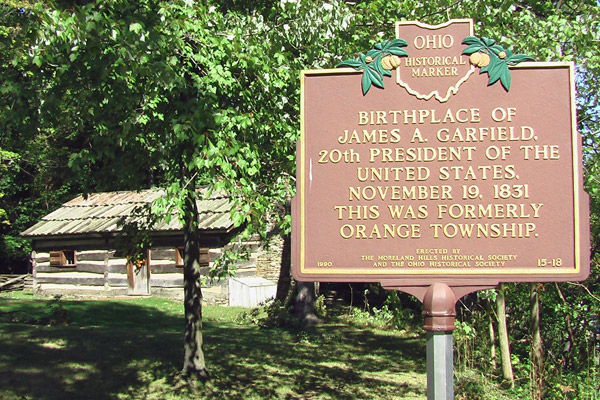
Moreland Hills: Behold the pageantry and glory of James A. Garfield!
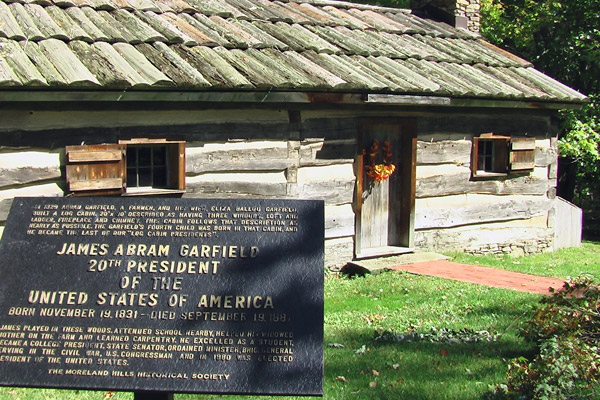
The cabin isn't real, but the feelings of joy you'll experience aren't fake.
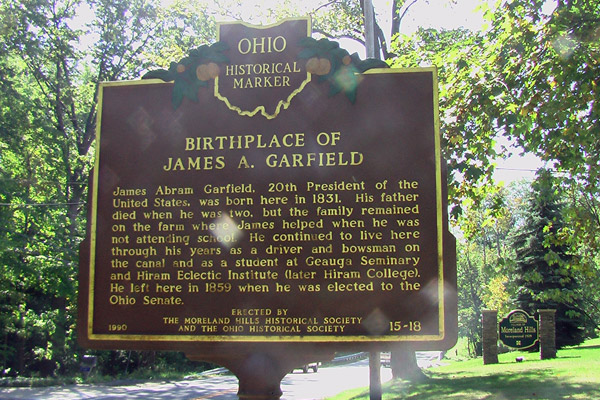
I saw the sign. Now you've seen it too. You're welcome.
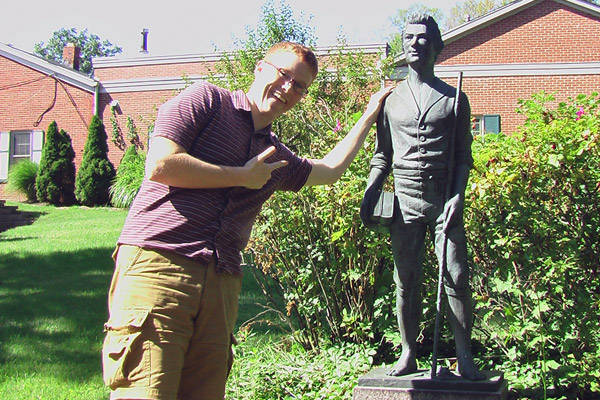
My understanding is that Garfield was slightly bigger in real life.
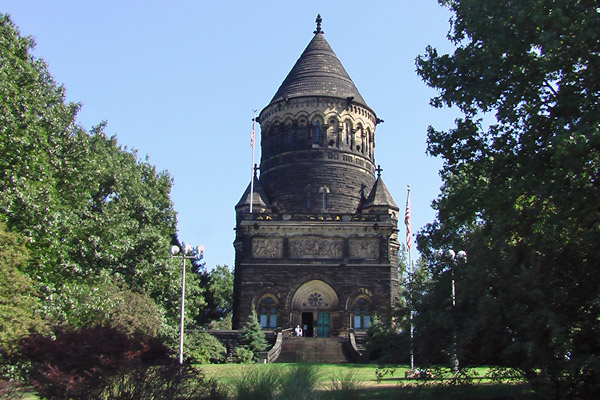
Lake View Cemetery: Easily one of the most kick-ass presidential resting places.
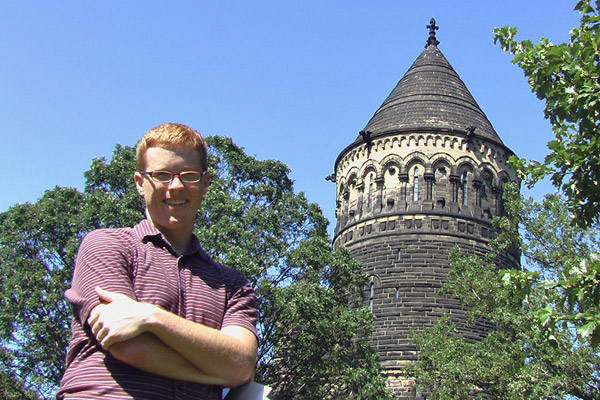
Lave View: Yes, the memorial is even taller than ME. Crazy.
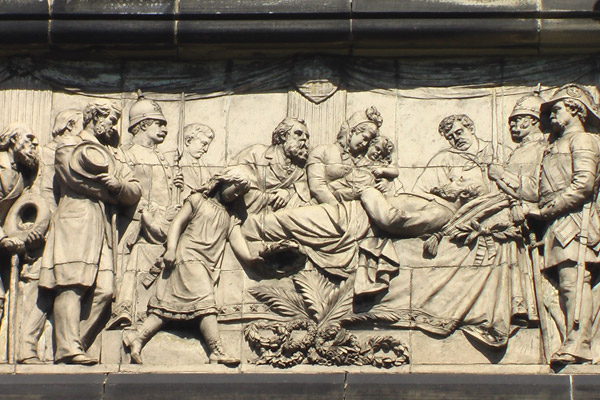
They went all in on this thing. Check out the frieze on the side.
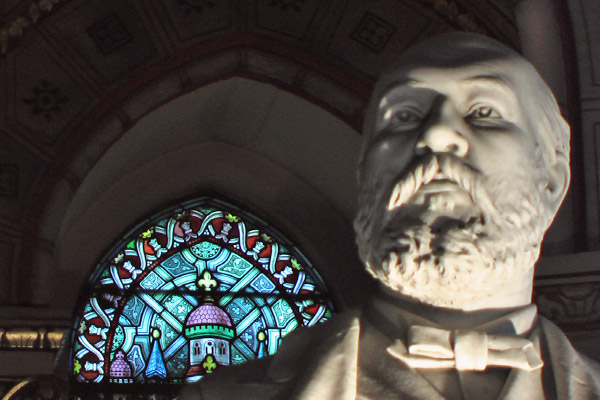
The Garfield statue inside the memorial. Awww yeah.
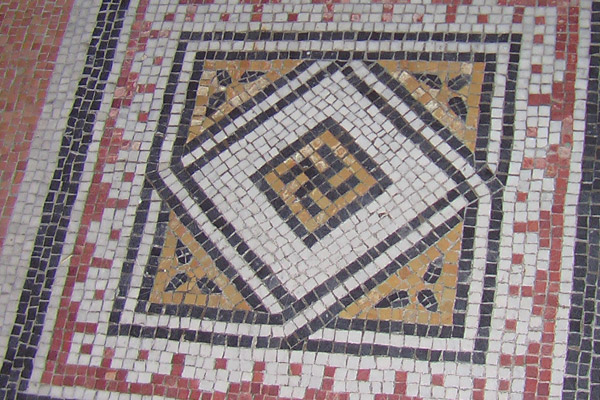
A friendly reminder that Garfield died before swastikas were considered bad.
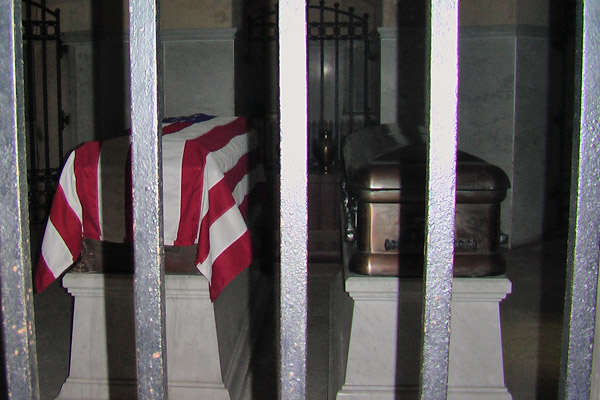
Not a great photo, but James and Crete are behind bars in the middle of the memorial.
If you knew that a guy could write Latin with one hand and Greek with the other, at the same time, and you had to guess what kind of building that guy grew up in, you'd guess monastery or Skinner Box or something along those lines, right? What are the odds that the guy comes from a log cabin?
Well James Garfield beats those odds! Lord Jim was the last of the log cabin Republicans, before that meant something completely different. Today, his birthplace is in suburban Cleveland, but in 1831 the region was still a fairly dense woodland. James was born in a log cabin on a frontier farm. He was the youngest of five kids, and his father died when he was very young. From that point on, Garfield lived a life of sturdy self-sufficiency as he helped keep his family afloat.
Considering Garfield's modest origins, he did very well for himself. He became a minister, a teacher, a general, a politician and an orator. So you shouldn't ever feel bad about cramming your kids into small spaces, such as log cabins or the trunks of cars. It might help them to one day be president.
There's not much to see at the Garfield birthplace. There's a delightful historical marker, a statue of young James, and a replica log cabin that is mostly notable for its very tiny size. (The Garfields were apparently on the cutting edge of the "tiny house" movement.) But that just means you'll have more time to spend pondering the omega of Garfield's existence, at beautiful Lake View Cemetery.
The Garfield Monument is a bit shocking in both size and detail. Today, Garfield is a historical footnote; we barely learn about him in school. But there was a tremendous outpouring of grief at the time of his assassination, and the end result was a stunning 180-foot tower made of Ohio sandstone at a cost of $135,000. The monument was dedicated in 1890, just nine years after Garfield kicked the bucket. There are parapets and gargoyles, and from the tower balcony you have a boffo view of downtown Cleveland and the shores of Lake Erie. And if that's not impressive enough, there are life-sized bas-relief panels around the exterior showing scenes from Garfield's life (and untimely death).
The interior is also a jaw-dropper. A rotunda features a striking statue of Garfield, surrounded by stained glass windows and mosaics of figures representing war, peace, the 13 original states and Ohio. For example, Delaware's window has a woman collecting a $5 toll from a Pennsylvanian trying to drag a sales-tax-free refrigerator across the state line. I'd love to show it to you, but the cemetery doesn't allow publication of interior photos without special permission. The crypt below has Garfield, his wife Lucretia, and his daughter and son-in-law.
There has to be some good part to getting shot in the spine for your country, right?
James A. Garfield National Historic Site, Mentor, Ohio
Visited in 2007 and 2013.
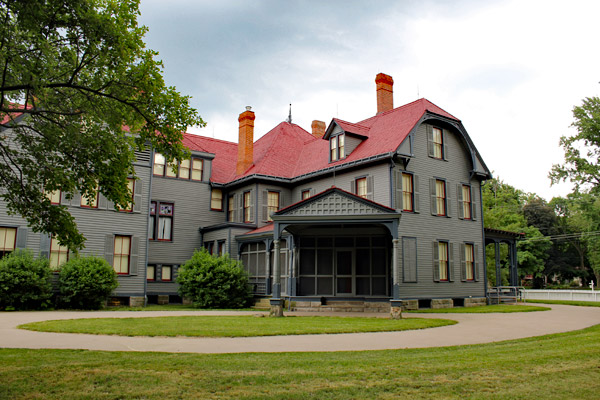
Get on my Lawnfield! Garfield's last home also became a memorial.
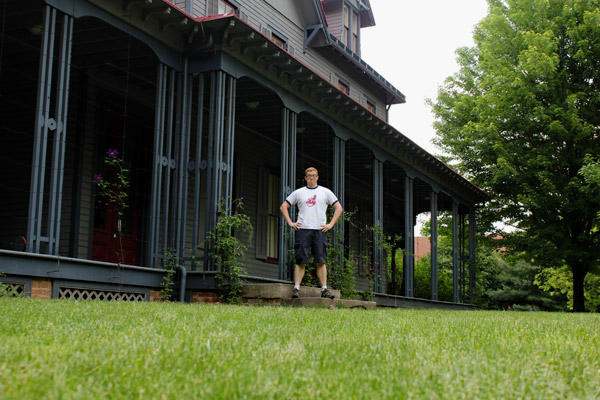
The historic porch, of campaign fame. Garfield did not wear a Chief Wahoo shirt.
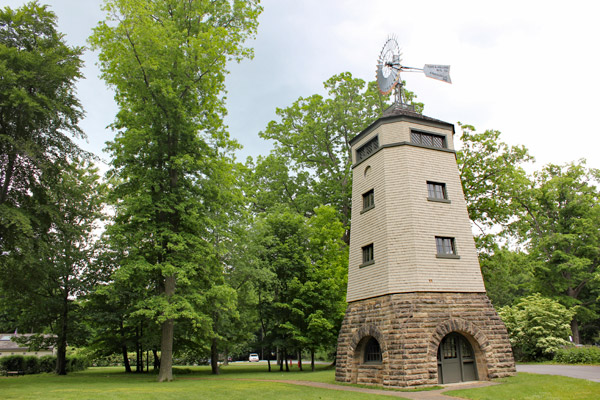
The grounds at Lawnfield include this cool ... uh ... windmill watchtower?
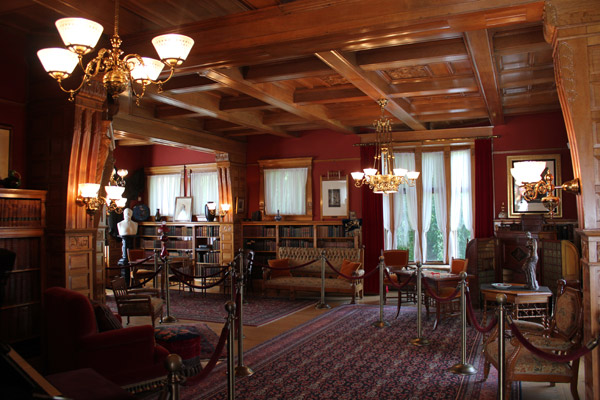
The memorial library is one of the coolest rooms in any presidential home.
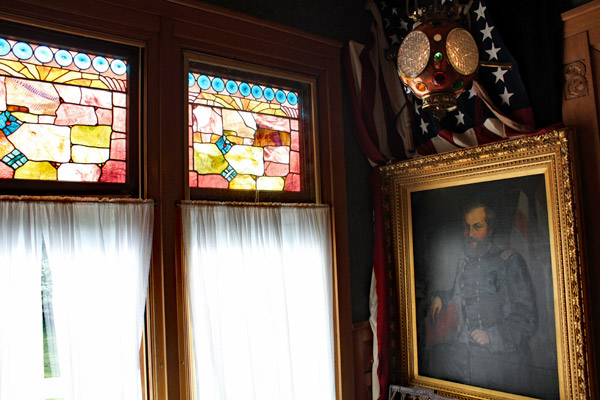
Some of the decorative flourishes on the stairs to the second floor.
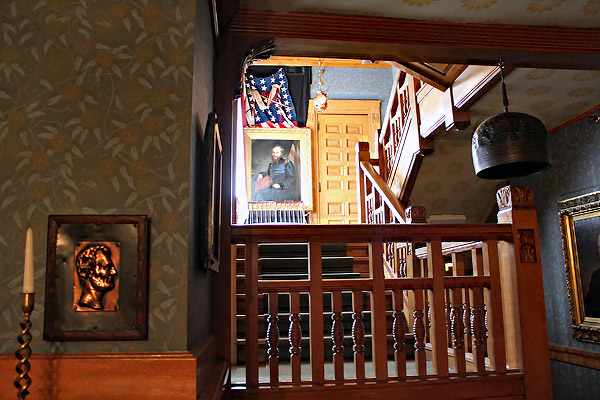
Despite rumors to the contrary, Garfield could and did use stairs.
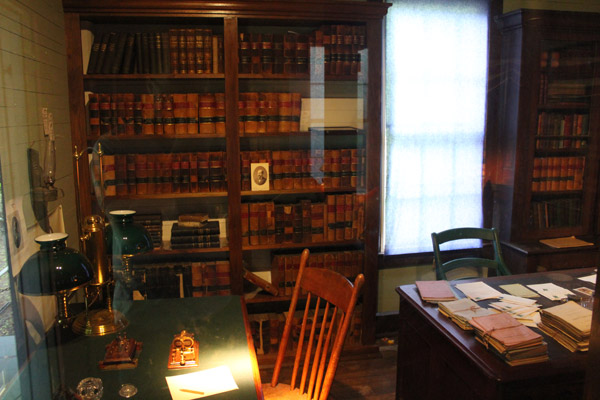
The outbuilding that hosted the telegraph office and mini-library.
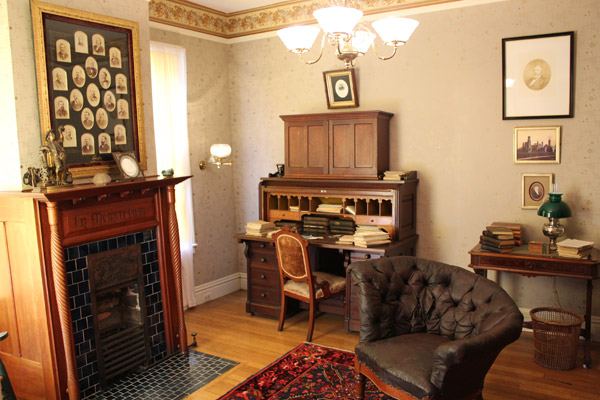
Garfield's office, including a favorite chair and a memorial fireplace. Warm your tears!
One of the great virtues of Ohio is its historical density. If you want to see four or five presidential sites I a day, it's possible with just a little bit of advanced planning. Another great virtue is ... Well, there's only one great virtue of Ohio. Especially since they closed the original Wendy's in Columbus. Those dicks.
I spent the morning of May 31, 2013, going to (various) town(s) on William McKinley. For the afternoon, I had enough time to stop in on a guy who blazed the trail McKinley walked. Without James Abram Garfield, the nation never would have known that it was possible to murder a president from northeast Ohio.
The first time I stopped by Garfield's home -- east of Cleveland, and not too far from the lake -- was 2007. I was young, and foolish, and I took terrible notes. My interest in the presidents had just started to take off, and I didn't know back that that it would become a crippling social disorder. When I took that tour, I had no idea that I wasn't focusing hard enough.
Fortunately, history is usually there waiting for you when you get back. The Lawnfield estate in Mentor was still standing in 2013, and after a 90-minute drive from Canton I was ready to correct a horrible wrong from my past. It felt great. As soon as I revisit all of the presidential homes, I'll be sure to apologize to that kid who got sent to jail after I hid all the cocaine I was dealing in his gym locker.
Garfield lived in Mentor the last few years of his life. He had been living in Hiram, where he had been a university president and all-around bearded wonder. He spent a lot of the year in D.C. as a congressman, and in 1872 he sold his Hiram home. His family lived in Washington with him most of the year, and they rented places in Ohio during the summers. Around 1876, there was a redrawing of the congressional map, and Democrats arranged to cut Garfield's "home county" out of his district. He decided to get around that gerrymander by moving to Lake County and running for office from there. The Garfields bought the 120-acre farm now known as Lawnfield.
It was kind of a dump. But it was close to a rail line, and it was fixed-up enough by 1880 to serve as the setting for the "front porch" campaign -- arguably the first of its kind. People wanting to hear the presidential nominee would get off the train, walk to his home, then enjoy a lecture by the man. Garfield was using a small outbuilding as his library; he had that converted into a telegraph office. It's where the news of his presidential victory reached him. He had his family around him, and a smile in his heart.
And in the summer of 1881, he also got a bullet in his back. The house as we see it today is really his widow's. Lucretia (aka Crete) spent the decades after Garfield's death stage-managing his memory. She built a "memorial library," which is the most awesome thing on the tour. The guides call it a $30,000 addition to a $5,000 house. Garfield's office was frozen in time after a few memorial features were added, and Lucretia stashed all his papers in a giant bank-style vault just off the new library. She wore black and wrote on widow's stationery for the rest of her days. She also had to take care of Garfield's mother Eliza, who outlived her son by seven years. According to the good men and women of the National Park Service, Eliza was a bit of a bitch.
I liked Lawnfield the first time I visited, and I liked it just as much the second time. The Garfields had a nice house, and at heart they seemed to be modest people. I asked for the stories behind half the things on the walls, and most of the time the answer was "they saw it on sale and thought it looked cool." It's a little sad to see the shrine-like setups in Garfield's old office and his mother's room, but for the most part it has a nice, homey feel.
When I go back in 2019, we'll see if it still holds up.
And what the heck ...
The Front Porch Speech
Gentlemen, welcome! Our Union stands today on the ramparts of a fortress built from our triumphs. And upon my lawn. Look, if you could just please stay inside the cordons, it would make Lucretia so happy. We just resodded, and you know how women are about these things. Thank you.
But even so, cordons, my fellow citizens, are not to be feared, or loathed, but embraced. For as we stare down from the mighty fortress into the Valley of Prosperity into which we must venture, the cordons of law and liberty delineate a path free from peril, a path unspoiled by discarded chicken wings.
I'm looking at you, gentle sir in the straw hat. Don't act like you don't know what I'm talking about. I was staring right at you when you dropped it. It's free food, the least you can do is move four feet to a garbage can. NOW! Yes, I'm going to wait.
Was that so hard?
But you see now the great struggle of this experiment, this self-government which we hold so dear. We must be eternally vigilant against the straw hats of this world, as we learned in the great conflict that so rent our nation's core and sweet Christ who took a dump in the rosebush? Do you think this is funny? There are like five outhouses right there! My kids play on this lawn, I don't want to think that they're running around with you cads dangling your privates out in broad daylight. Heavens forfend!
You're not even listening. I have about 15 minutes here on civil service reform that we really need to get through here. The great machinery of democracy cannot function with the gear so clogged by insidious clients of patronage.
Screw this, can you even HEAR me over the brass band? Please go away! No one invited you here. Don't give them any money, I beg you. They play all hours of the night and we are sorely taxed. Lucretia cries when she hears a march anymore. She CRIES. Did someone drop another chicken wing? We aren't running Stop laughing!
To conclude, as I fire this shotgun into the air, I assure you it is loaded not with the rock salt of temerity, but in fact the shells of righteous indignation. Our nation will sail steadfast and true into the Harbor of Opportunity, but only after you bastards get off my lawn. I know where you live.
Vote Republican.
Deathsite: Elberon, New Jersey
Visited in 2016.
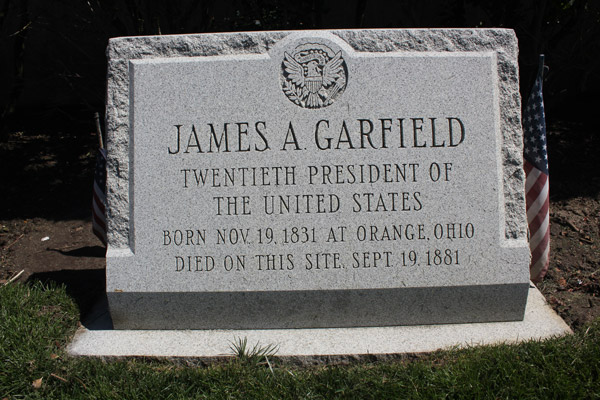
Sadly, he died before meeting the cast of "Jersey Shore"
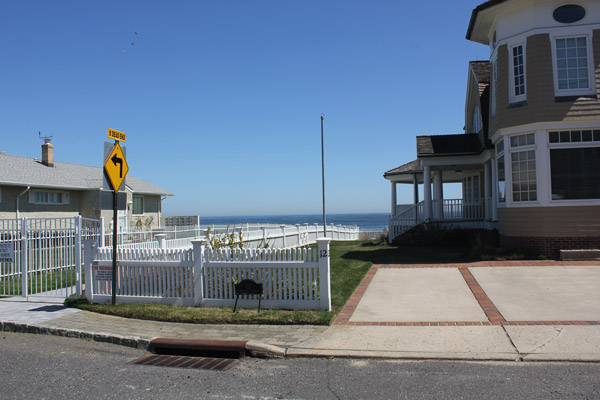
Garfield's deathsite is by the ocean. No mermaid magically healed him. Sigh.
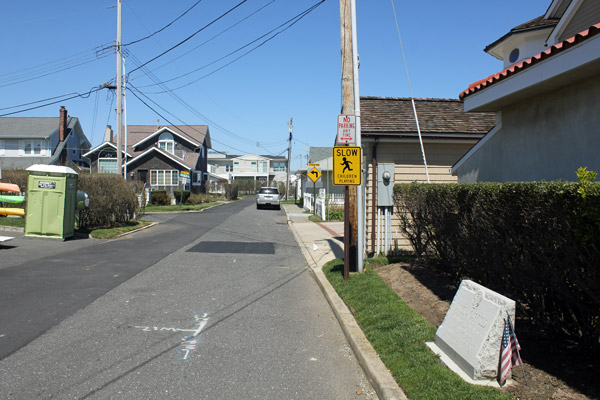
The view down the street. It's a little less ritzy than it was in 1881.

Reverse angle of the marker. That home is not the original cottage where he died. Sorry.
History tells us that Charles Guiteau killed James Garfield. The reality is more complicated.
Guiteau was insane. He convinced himself that he had strong personal relationships with powerful politicians. He gave an incoherent speech supporting Garfield during the 1880 campaign, thought it was crucial to Garfield's victory, and expected a reward. When Garfield did not appoint him to a diplomatic post -- Garfield had almost no concept of who Guiteau was -- he swang for the fences. On July 2, 1881, Guiteau tracked Garfield to a Washington, D.C., train station and shot him. His expectation was that Vice President Chester Arthur, a member of the "Stalwart Republican" faction competing with Garfield, would be filled with gratitude for the man who made him president. And then Arthur would issue a pardon and give Guiteau a job. If this plan had worked, Guiteau would now be known as the inventor of the vision board.
So, right there, you can point a finger at Republican Party politics, the failures of the 19th century mental health system, or the godawful security of 1880s Amtrak.
But the real fault lies in 19th century medicine. Guiteau was not a particulary good assassin, and he didn't do a particulary good job shooting Garfield. A mediocre ER doc from the 21st century would have removed the bullet, patched up the wound and nuked the patient with enough antibiotics to kill a horse. Garfield would have been sore for a few weeks, but he would have pulled through and enjoyed three more years of awkward eye contact with Chester Arthur at GOP mixers.
The president's actual medical team, however, choked. They couldn't locate the bullet, and every time they tried to remove it they shoved unsterilized fingers and instruments into Garfield's wounds. Alexander Graham Bell tried to invent a metal detector just to find the bullet, but the doctors didn't realize that the metal frame of Garfield's bed screwed up its readings. Infections turned Garfield into a giant puss bag, and after a few weeks it was pretty clear that the president was on the way out.
The last hope was that the ocean air would make him better, or at least provide some comfort in his final days. People had a lot of faith in ocean air back then, because that somehow seemed like a better treatment than "maybe wash your hands before shoving them inside the president." In early September, Garfield was shipped by train to Long Branch, N.J., one of his past vacation sites. (It was actually where he was headed in early July, and Ulysses Grant had vacationed in Long Branch as well.) The people laid special rail lines so that the ailing president could roll straight up to the place where he'd be staying: a rich guy's 20-room cottage right on the Atlantic Ocean.
Garfield died there, about two weeks later. The puss won. The fancy cottage is gone, and the special rail line is gone. They took the railroad ties and made them into a "tea house" in a nearby park, but it's pretty beat up and it wasn't open when I drove through. But someone did have the presence of mind to put a small granite marker on the curb where the cottage once stood. You can visit it, and take selfies with it, and set up a lawn chair next to it drinking a 40 until someone calls the cops. It's maybe the most fun you can have at the Jersey Shore that doesn't involve recreational drug use and not-up-to-code amusement parks.
Mutter Museum, Philadelphia, Pennsylvania
Visited in 2009.
In 1893, President Grover Cleveland was dismayed to find a rough patch on the roof of his mouth. This was problematic, not only because it was cancerous, but because it threatened Cleveland's favorite pastime of eating like a hog. Rather than shatter the entire economy by making the news of his bumpy mouth public (as Grover Cleveland was the glue holding our fragile nation together), he said he was going fishing. Then he slipped onto a yacht in the East River and had surgeons secretly remove a small chunk of his head.
I share this delightful tale of Americana because I have visited that small chunk at Philadelphia's Mutter Museum. It's a medical museum dating to the 1860s, still organized along the principles of mid-19th century medicine: hideous deformities in delightful wooden cases. You owe it to yourself to go.
Now, maybe you're saying, "Chris, I don't much care for Grover Cleveland. His use of the veto was both obstructive and philosophically undemocratic." Well then, why not go for the PIECE OF JAMES GARFIELD?!?!?! Yea, a dollop of skin from James Garfield's back, removed during his autopsy, now sits on a Mutter Museum shelf as plain as day. Maybe your travel plans will never take you to Garfield's tomb, but if you're in Philly you can still pay your respects to a pinkish-white divot of our 20th president, who died of ... uh, mid-19th century medicine.
What's that? You despise James Garfield, too? Well the Mutter has got you covered, you hateful bastard -- you can tip your cap to a chunk of the brain of the GUY WHO SHOT GARFIELD! It looks like lasagna noodles, and it's just a few shelves down from the thorax of John Wilkes Booth. But the Mutter is so much more than small pieces of presidents and assassins:
- A wall of skulls. Sometimes, you'll be walking through a museum, and you'll think: "These displays are very nice, but I was really hoping for a floor-to-ceiling monument to death." Not a problem at the Mutter! Just find the wall of brain samples from the criminally insane, then turn around. You can't miss it.
- Human leather. Nowadays, if you make any kind of personal posession out of another human being, then you get your own special on MSNBC. But there was a more romantic and civilized time in this country, when respected men could make leather out of people, then use it in the binding for an anatomy textbook. And guess where you could see such a book? Awwwwww yeah.
- Siamese twins. The Mutter has not only a plaster cast of Chang and Eng -- the original Siamese twins -- but also the liver that they shared. This is relevant, in that one of the brothers was a surly drunk while the other was not. Also, did you know that they married sisters and had 22 kids between them? I bet you feel super bad about using Match.com now, huh?
- Megacolon. Sometimes the nerves in your colon shut off, stopping the peristaltic motion needed to move waste matter through your digestive system. Those who doubt the resilience of the human body would assume these leads to quick death. Those who visit the Mutter Museum knows it leads to a colon as thick as telephone pole and about five feet long, on display in the Mutter Museum after a slow, painful death. This actually happens! There are some people who actually allow their colon (or ovarian cyst, or whatever) to get this big! "I can't drop those last 125 holiday pounds," they might say. "I wonder if it has anything to do with me not going to the bathroom for the last 8 months ... hmm ... Nah. Pass the cheese."
- A lady whose body has turned to soap. Sadly, this is not in the bathroom next to a lady whose body has turned to paper towels, but it's still kind of neat. She's in the "Han Solo in carbonite" pose.
It is a tremendous collection, from the shrunken heads on down. It is a museum that preserves not only medical specimens, but also my hope that doctors will one day be able to clone Grover Cleveland without having to desecrate his grave, then run him for a third term on a bipartisan ticket with a clone of James Garfield. But I must take issue with one display.
I can handle fetuses in jars or diseased genitalia samples. But the jar of extracted kidney stones may be the most evil object on the entire planet. Concentrating that much suffering in one location might open a portal to a hell, allowing the armies of Satan to run roughshod o'er the mortal plane. This jar should be either destroyed or featured prominently in a comedy/horror screenplay.
That aside, I have to recommend this fine establishment. Though you cannot take pictures inside, it is the kind of institution that sells a megacolon postcard in the gift shop, right by the Gingerbread Siamese Twin cookie cutters.
National Museum of Health and Medicine, Silver Spring, Maryland
Visited in 2012.
I sometimes miss the elegance of the 19th century: rail travel, Victorian manners, and the social acceptability of putting splintered and diseased body parts in a public museum.
A few years ago, I had the great pleasure of stopping by Philadelphia's Mutter Museum, which is a freak show behind glass. That museum has a slightly more tasteful cousin in the National Museum of Health and Medicine in suburban Washington. It was at the Walter Reed military hospital, until some jerk reporters "investigated" to find out that "wounded soldiers were being horribly treated" and they had to close the whole place down. Jerk reporters. A few years later, they finally unpacked what had to be the creepiest storage locker in the world, and the museum has been reborn in Silver Spring, Maryland. I enjoy creepy things, so me, the wife and some friends went to check it out.
It could use more disturbing and haunting deformities, but it's not bad. The real spine of the collection (which includes quite a few spines) is shattered body parts from the Civil War. A guy took a cannon ball to the face, Army doctors couldn't do too much to help him, no one cared about sending his remains back to his dirty rebel family, and presto, you've got yourself a nice centerpiece for the "people shot in the face with cannons" wing. There are cases of broken legs, arms, skulls and ribs, and you get the impression that they've got an Indiana Jones warehouse in the back with a few hundred more crates.
But bones along are boring, so they expanded the collection over the years. That's how it always works: Word gets out that you have a smashed bone collection, then someone on vacation in Thailand sees an elephantitis scrotum in a shop window and thinks of you. You can't turn that down, so now you also collect elephantitis scrotums. Might as well put them in the museum. There's actually a great case of diseased and damaged organs, and the descriptions are off to the side. So you can play a rousing five-minute game of Guess That Disgusting Ailment. There are no winners. Especially not the guy with the elephantitis scrotum.
They also threw in some cool doctor relics, like Civil War medicine bags and saw kits. There's a tiny box with extending electrodes and a hand crank -- it the 1870s version of an electroshock machine. They have the precursor of the artificial kidney, which is the size of very large BBQ grill.
But the highlight for me will always be presidents. A few of the crown jewels from the old Walter Reed Museum are still on display.
First is the bullet that killed Lincoln. If you want to be accurate, it's the bullet that made Lincoln a vegetable -- doctors shoving their fingers in his brain probably killed him. But it's there, and it's shiny and not at all menacing. The bullet is right next to a few chips of Abe's skull, a doctor's cuff soaked with his blood and some of his hair. If an evil genius ever wants Lincoln DNA for the next Serpentor, I know where they're headed.
Far grosser (and cooler!) is James Garfield's vertebrae. Garfield was definitely killed by doctors; they thought the bullet in his body was on the other side from its actual location, and the quack in charge of his medical care didn't really believe in antiseptic medicine. (It was a hot new fad at the time.) He kept shoving dirty things in Garfield's body until the poor guy was basically held together by puss and infections. When they did the autopsy, the doctor for some reason yanked out a couple of Garfield's vertebrae that had been nicked by a bullet, then put them somewhere for safe keeping. Why? Beats me. But now they're in a museum. Next to the Lincoln bullet. Any political opponent who called James Garfield spineless was only partially right, and then only after his death.
I'm willing to bet that they have most of John Wilkes Booth and Charles Guiteau in the storage room (a few pieces of their bones and brains have been on display). New presidents are probably invited over at the start of their term to kick those corpses square in what's left of their junk. It's all strictly confidential, of course, but I'm about 95 percent sure that this happens. Or at least it should.
The museum is small, but it is free, and for that reason I heartily endorse it. You cannot make a museum like this anymore, without people accusing you of kidnapping Chinese peasants and killing them for your anatomy exhibit. The 19th century was so much cooler, except for the slavery and disease.
